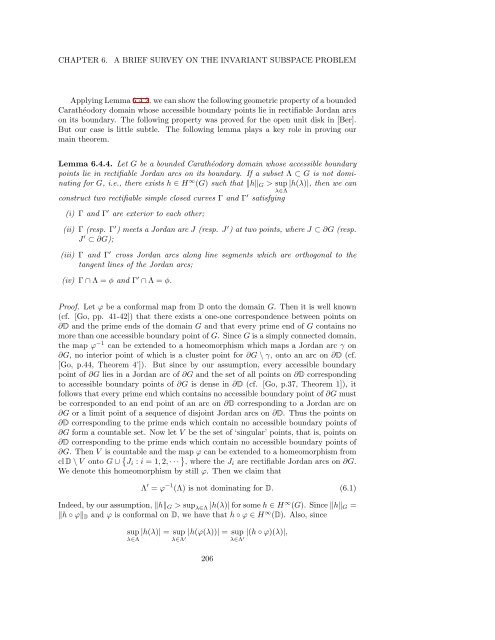Woo Young Lee Lecture Notes on Operator Theory
Woo Young Lee Lecture Notes on Operator Theory
Woo Young Lee Lecture Notes on Operator Theory
You also want an ePaper? Increase the reach of your titles
YUMPU automatically turns print PDFs into web optimized ePapers that Google loves.
CHAPTER 6.<br />
A BRIEF SURVEY ON THE INVARIANT SUBSPACE PROBLEM<br />
Applying Lemma 6.4.2, we can show the following geometric property of a bounded<br />
Carathéodory domain whose accessible boundary points lie in rectifiable Jordan arcs<br />
<strong>on</strong> its boundary. The following property was proved for the open unit disk in [Ber].<br />
But our case is little subtle. The following lemma plays a key role in proving our<br />
main theorem.<br />
Lemma 6.4.4. Let G be a bounded Carathéodory domain whose accessible boundary<br />
points lie in rectifiable Jordan arcs <strong>on</strong> its boundary. If a subset Λ ⊂ G is not dominating<br />
for G, i.e., there exists h ∈ H ∞ (G) such that ∥h∥ G > sup |h(λ)|, then we can<br />
λ∈Λ<br />
c<strong>on</strong>struct two rectifiable simple closed curves Γ and Γ ′ satisfying<br />
(i) Γ and Γ ′ are exterior to each other;<br />
(ii) Γ (resp. Γ ′ ) meets a Jordan arc J (resp. J ′ ) at two points, where J ⊂ ∂G (resp.<br />
J ′ ⊂ ∂G);<br />
(iii) Γ and Γ ′ cross Jordan arcs al<strong>on</strong>g line segments which are orthog<strong>on</strong>al to the<br />
tangent lines of the Jordan arcs;<br />
(iv) Γ ∩ Λ = ϕ and Γ ′ ∩ Λ = ϕ.<br />
Proof. Let φ be a c<strong>on</strong>formal map from D <strong>on</strong>to the domain G. Then it is well known<br />
(cf. [Go, pp. 41-42]) that there exists a <strong>on</strong>e-<strong>on</strong>e corresp<strong>on</strong>dence between points <strong>on</strong><br />
∂D and the prime ends of the domain G and that every prime end of G c<strong>on</strong>tains no<br />
more than <strong>on</strong>e accessible boundary point of G. Since G is a simply c<strong>on</strong>nected domain,<br />
the map φ −1 can be extended to a homeomorphism which maps a Jordan arc γ <strong>on</strong><br />
∂G, no interior point of which is a cluster point for ∂G \ γ, <strong>on</strong>to an arc <strong>on</strong> ∂D (cf.<br />
[Go, p.44, Theorem 4’]). But since by our assumpti<strong>on</strong>, every accessible boundary<br />
point of ∂G lies in a Jordan arc of ∂G and the set of all points <strong>on</strong> ∂D corresp<strong>on</strong>ding<br />
to accessible boundary points of ∂G is dense in ∂D (cf. [Go, p.37, Theorem 1]), it<br />
follows that every prime end which c<strong>on</strong>tains no accessible boundary point of ∂G must<br />
be corresp<strong>on</strong>ded to an end point of an arc <strong>on</strong> ∂D corresp<strong>on</strong>ding to a Jordan arc <strong>on</strong><br />
∂G or a limit point of a sequence of disjoint Jordan arcs <strong>on</strong> ∂D. Thus the points <strong>on</strong><br />
∂D corresp<strong>on</strong>ding to the prime ends which c<strong>on</strong>tain no accessible boundary points of<br />
∂G form a countable set. Now let V be the set of ‘singular’ points, that is, points <strong>on</strong><br />
∂D corresp<strong>on</strong>ding to the prime ends which c<strong>on</strong>tain no accessible boundary points of<br />
∂G. Then V is countable and the map φ can be extended to a homeomorphism from<br />
cl D \ V <strong>on</strong>to G ∪ { J i : i = 1, 2, · · · },<br />
where the J i are rectifiable Jordan arcs <strong>on</strong> ∂G.<br />
We denote this homeomorphism by still φ. Then we claim that<br />
Λ ′ = φ −1 (Λ) is not dominating for D. (6.1)<br />
Indeed, by our assumpti<strong>on</strong>, ∥h∥ G > sup λ∈Λ |h(λ)| for some h ∈ H ∞ (G). Since ∥h∥ G =<br />
∥h ◦ φ∥ D and φ is c<strong>on</strong>formal <strong>on</strong> D, we have that h ◦ φ ∈ H ∞ (D). Also, since<br />
sup |h(λ)| = sup |h(φ(λ))| = sup |(h ◦ φ)(λ)|,<br />
λ∈Λ<br />
λ∈Λ ′ λ∈Λ ′<br />
206













